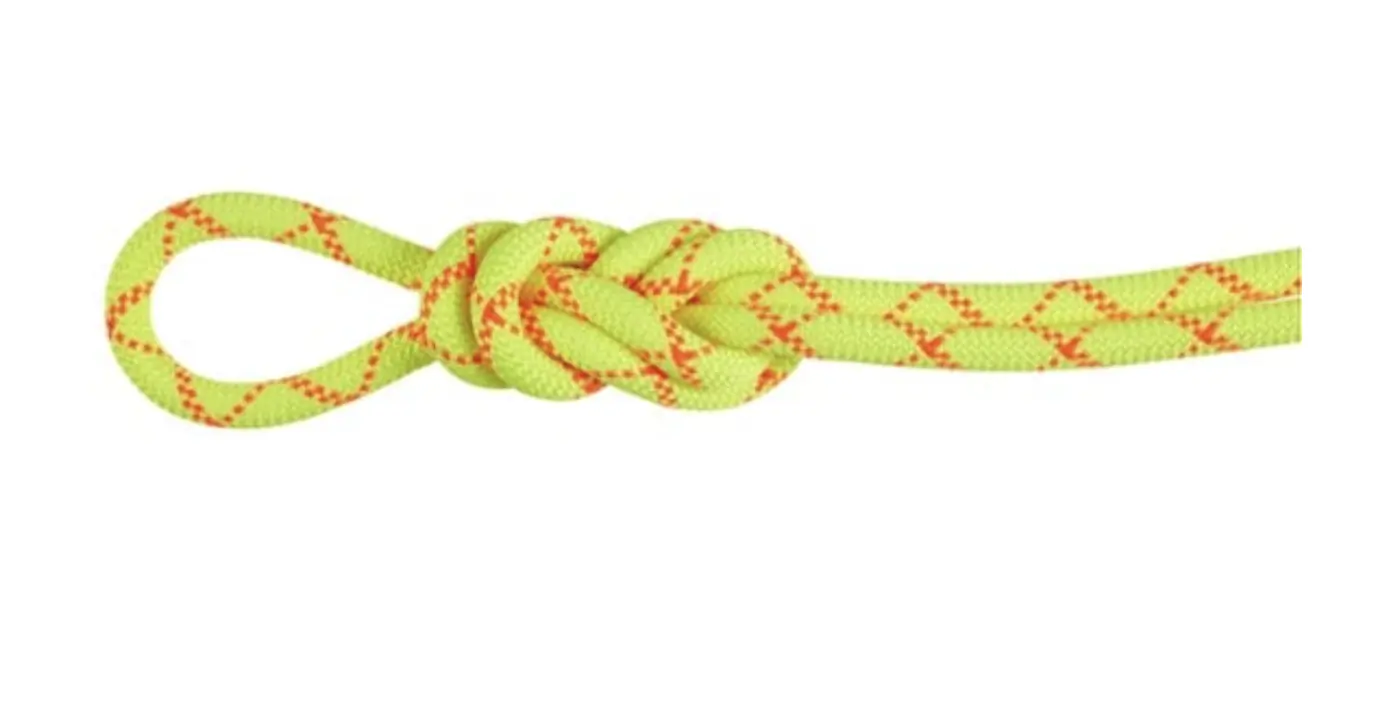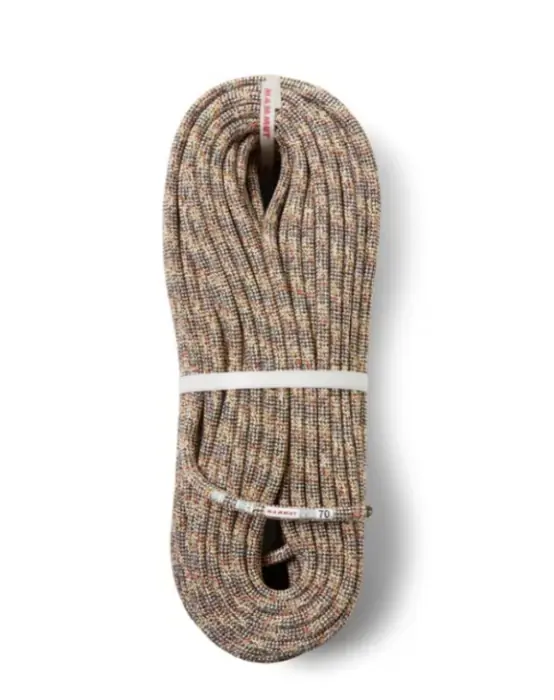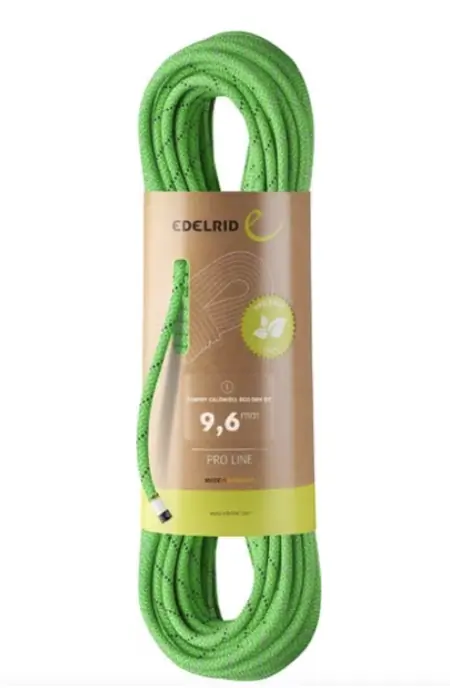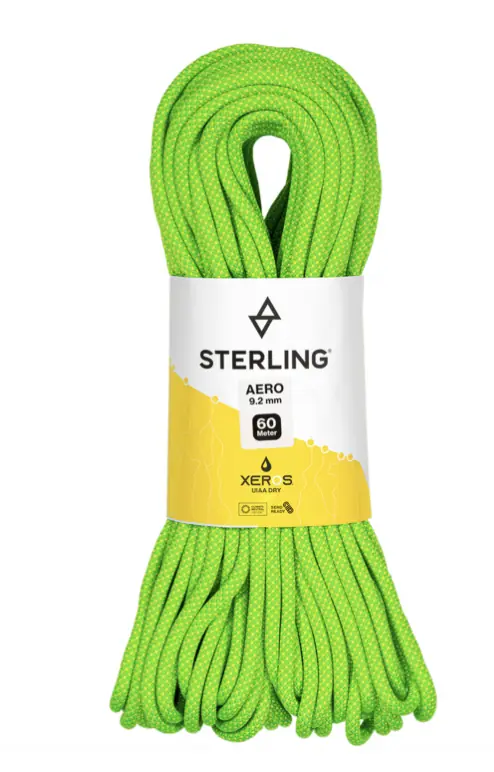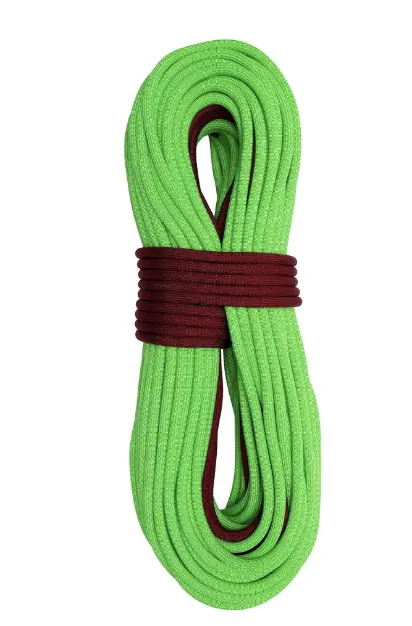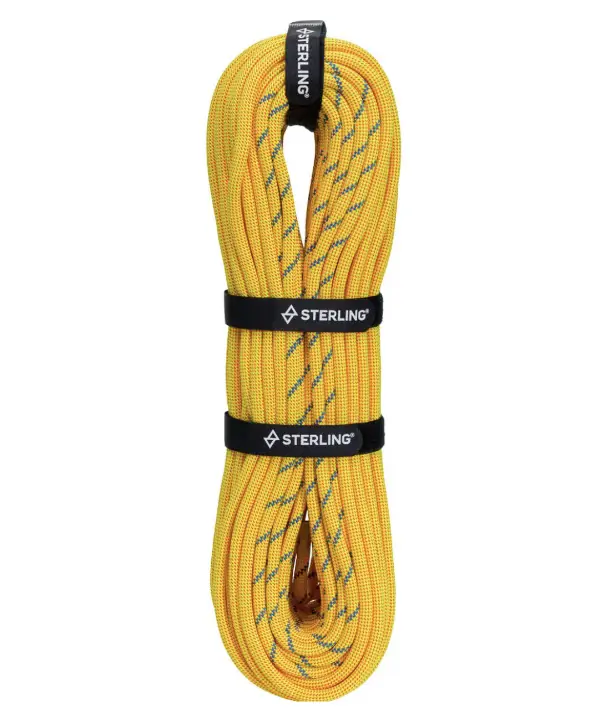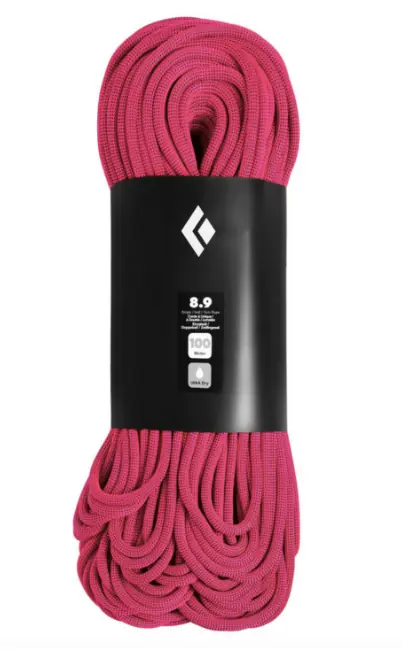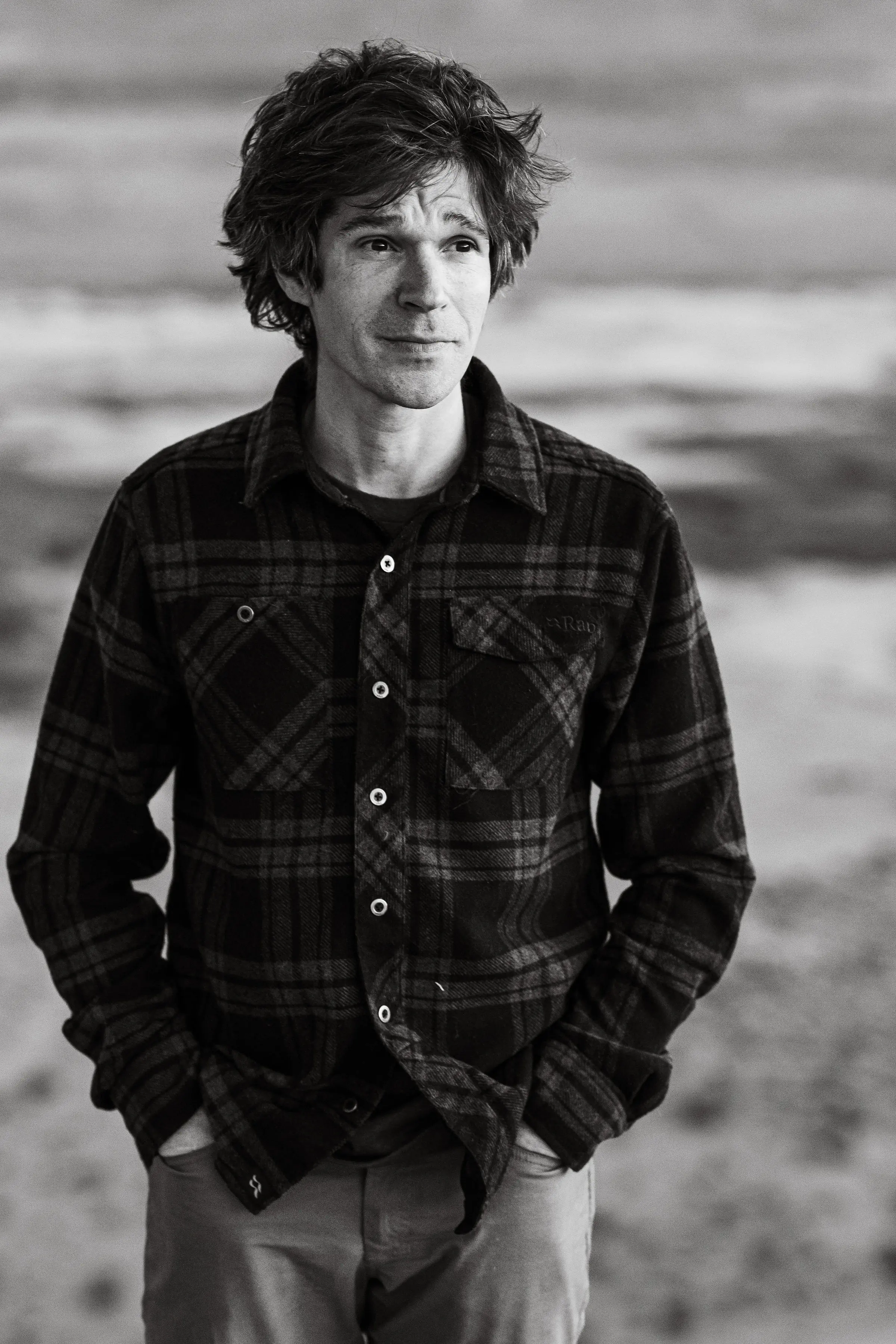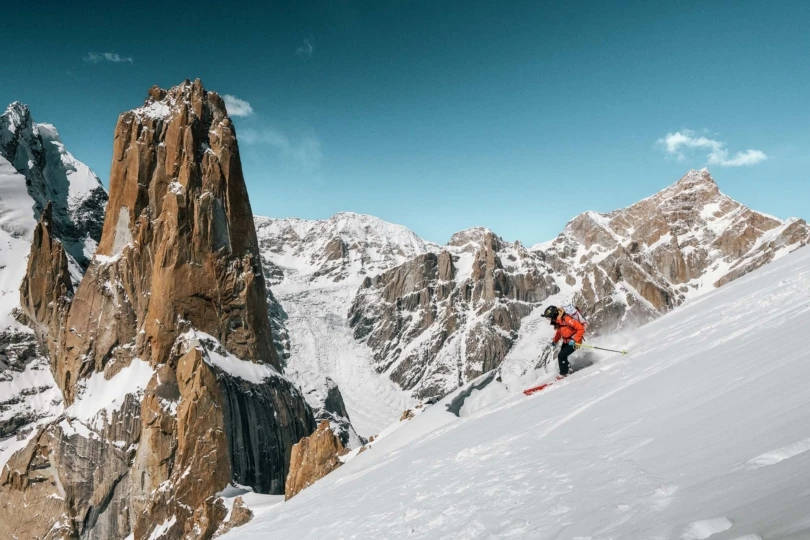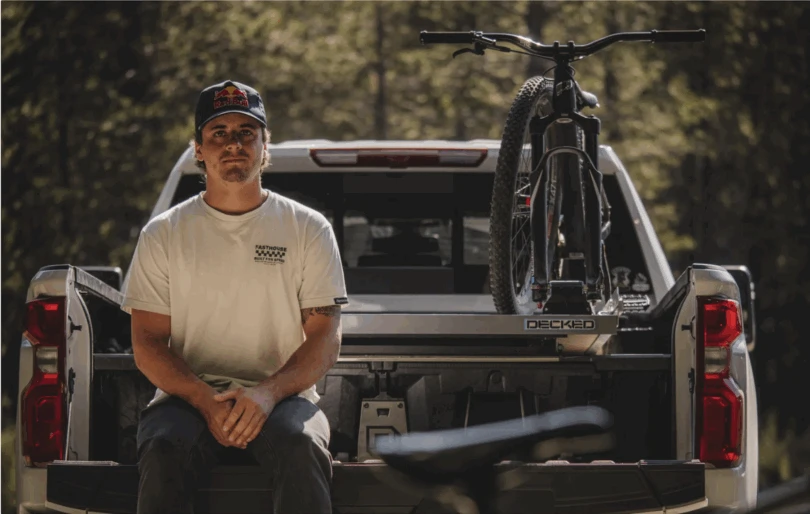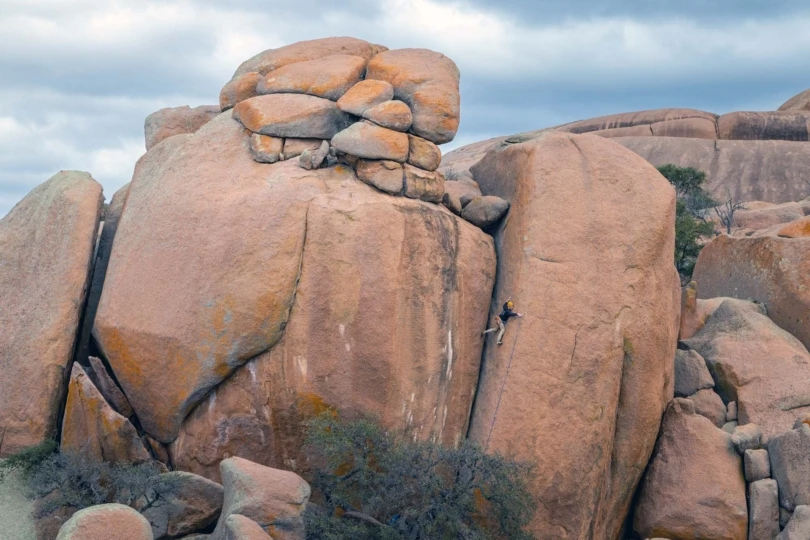A climbing rope is one of the most important pieces of gear you can buy. It is literally your lifeline, and can also make or break your experience climbing outdoors. There are a few important factors to look for when deciding which rope to buy, such as diameter, weight, performance, and feel, and you can’t discern all of these things behind the counter of a gear shop. That’s where we come in.
Our expert gear testers scoured the web for the best ropes on the market today and bought and tested seven ropes to see which stood out from the pack. We coiled, packed, hiked, climbed, belayed, whipped, and hang-dogged all over with nine ropes, seeing how soft their catches were and how smooth they ran through belay devices. We evaluated each one based on its weight, handling, stretch, and performance.
We lent them to friends to put them through the wringer and give us their notes to make sure we’re bringing you the most thorough review on the internet. Whether you’re buying your first rope or are a seasoned climber looking for something skinny and sendy, read on to find out what ropes we think rise to the top today.
Editor’s Note: On June 6, 2025, we added two of our favorite new cords to this guide. The Mammut Alpine Core Protect takes the top spot as our favorite rope, and the Edelrid Siskin is the lightest rope we’ve ever tested.
The Best Climbing Ropes of 2025
- Diameter: 9.5
- Weight: 59 g/m
- Dry treatment: Yes
- Good for: The one rope to rule them all
Pros
- Tough
- Dry treated sheath and core
- Light weight for its diameter
- Handles like a skinnier rope
- Reasonably priced
Cons
- Many alpine climbers will want a lighter rope
Mammut Crag We Care Classic 9.5
- Diameter: 9.5 mm
- Weight: 58 g/m
- Dry treatment: No
- Good for: All-around climbing
Pros
- Affordable
- Eco-friendly
- Lightweight
Cons
- Not dry-treated
Edelrid Tommy Caldwell Eco Dry DuoTec 9.6
- Diameter: 9.6 mm
- Weight: 62 g/m
- Dry treatment: Yes
- Good for: All-day cragging, big walls, working routes
Pros
- High sheath proportion for durability
- DuoTec design for safety
- Designed with pro climber Tommy Caldwell
Cons
- Heavy
- Gets stiff over time
Sterling Aero 9.2 XEROS
- Diameter: 9.2 mm
- Weight: 56 g/m
- Dry Treatment: Yes
- Good for: Sport climbing, trad climbing, alpine climbing
Pros
- Light
- Dry-treated
- Soft in hand
- Many lengths and bi-pattern available
Cons
- Expensive
- Can easily slip through a GriGri when new. Be mindful and belay carefully!
Trango Agility Duo Dry 9.1
- Diameter: 9.1 mm
- Weight: 56 g/m
- Dry treatment: Yes
- Good for: Sport climbing, trad climbing, alpine climbing
Pros
- “Red Flag” treatment has bright colors to identify ends for safety
- Triple-rated for single, half, and twin rope use
- Tighter 1×1 weave for durability
Cons
- No permanent middle marker
- Expensive
Edelrid Siskin 8.6 Eco Dry
- Diameter: 8.6 mm
- Weight: 48 g/m
- Dry treatment: Yes
- Good for: Sport climbing redpoint attempts
Pros
- Extremely low weight
- Very easy to clip
- Soft catches
- Supple feel
Cons
- Not as durable as larger diameter ropes
- Expensive
Other Great Climbing Ropes, Field Tested
- Diameter: 9.4 mm
- Weight: 57 g/m
- Dry treatment: Yes
- Good for: All-around climbing
Pros
- Dry treatment treats both core and sheath for superior performance
- Lightweight
- Bi-pattern enhances safety
- Tight sheath weave
Cons
- Expensive
- Maybe overkill for the gym climber
- Diameter: 9.8 mm
- Weight: 62 g/m
- Dry Treatment: No
- Good for: All-around climbing
Pros
- Made of eco-friendly materials
- Thermo shield treatment helps to retain a supple feel
- Affordable
Cons
- Not dry treated
- Diameter: 8.9 mm
- Weight: 52 g/m
- Dry treatment: Yes
- Good for: Sport climbing, ice climbing, alpine climbing
Pros
- Thin and light
- Good value
- Dry-treated
- Soft handling
Cons
- Not as durable as other models
- Middle marker fades quickly
Climbing Ropes Comparison Chart
| Rope | Price (70 meter) | Weight (Grams per meter) | Diameter | Dry Treatment |
|---|---|---|---|---|
| Mammut Alpine Protect 9.5 | $329 | 59 g/m | 9.5 mm | Yes |
| Mammut Crag We Care Classic 9.5 | $199 | 58 g/m | 9.5 mm | No |
| Edelrid Tommy Caldwell Eco Dry DuoTec 9.6 | $289 | 62 g/m | 9.6 mm | Yes |
| Sterling Aero 9.2 XEROS | $280 | 56 g/m | 9.2 mm | Yes |
| Trango Agility Duo Dry 9.1mm | $449 | 56 g/m | 9.1 mm | Yes |
| Edelrid Siskin 8.6 Eco Dry | $330 | 48 g/m | 8.6 mm | Yes |
| Sterling Ion 9.4 BiColor XEROS | $350 | 57 g/m | 9.4 mm | Yes |
| Edelrid Boa Eco 9.8mm | $199 | 62 g/m | 9.8 mm | No |
| Black Diamond 8.9 Dry Climbing Rope | $300 | 52 g/m | 8.9 mm | Yes |

How We Tested Climbing Ropes
Our GearJunkie testers and writers are avid climbers, with decades of combined experience climbing in all disciplines — sport, trad, big wall, ice, and alpine climbing. We’ve climbed all over the world, from Mexico to South America, France, Canada, and beyond. We’ve climbed on and retired dozens of ropes, taken hundreds of whips, belayed hundreds of partners, and we know that it’s the best feeling to buy a rope that actually lives up to the hype.
Our lead tester, Miya Tsudome, spent years working and climbing in Yosemite Valley as a climbing guide, eventually making her way to the high desert of Bishop, Calif., where she can climb year-round. As a more experienced climber, she owns several ropes that all serve different purposes and thus knows the small details that make a good climbing rope.
Miya tested this lineup of ropes over the course of a spring season, taking them out to her local crags of the Owens River Gorge and Pine Creek Canyon and evaluating them based on a series of metrics such as length, diameter, feel, durability, and design. She examined the feel of their sheath, tested each of them with lead and top rope falls, and observed how they handled through various belay devices to bring you an unbiased review of each of their strengths and weaknesses.
Whether you’re looking for an all-around workhorse of a rope that will last more than a season, or you want a thin line for sending your hardest sport climbing projects, we’ve got you covered in our extensive review. Be sure to complement your kit with a reliable harness and a solid climbing helmet.
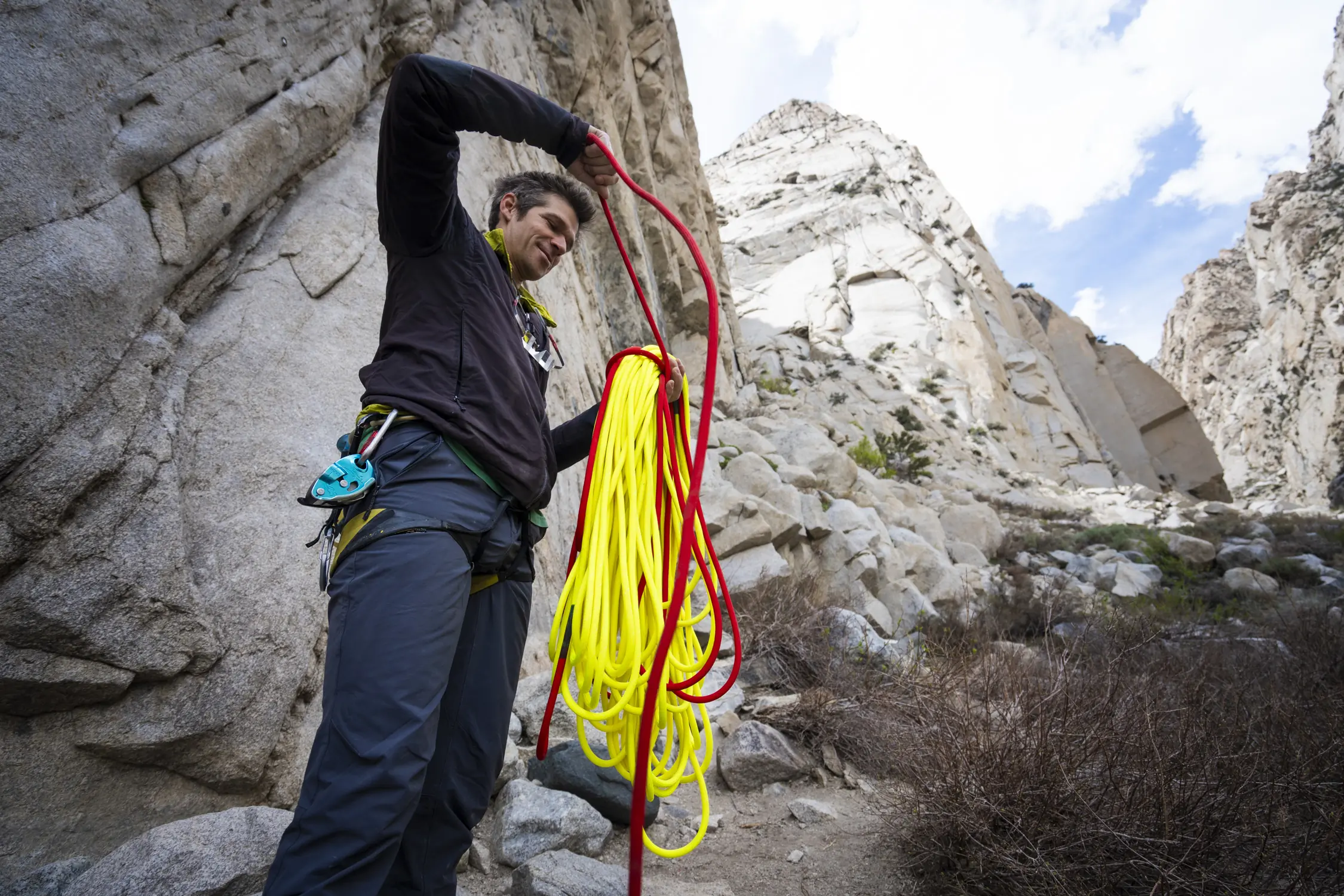



Buyer’s Guide: How to Choose a Climbing Rope
Most likely, the first thing you’re going to consider when buying a climbing rope is its length and diameter. The size of your climbing rope matters for many reasons. Firstly, what is the average pitch length at the crag where you plan on climbing? And secondly, what type of climbing do you plan on doing most?
Length
Whether you’re climbing at your gym or on the infamously long sport routes of Spain, the length of the rope you buy is important. If you only climb in the gym, or want a dedicated rope just for that, you’ll want to buy a 40-meter rope. Many manufacturers will make their popular ropes in this length, but the more specialized ropes will usually only come in 60, 70, and 80-meter lengths.
60 meters used to be the gold standard, as many of the classic climbing routes are typically no longer than 100 feet, or 30 meters long. But this depends greatly on the climbing area, and how modern the routes are. 70 meters, or 230 feet, seems to be the new standard and is an especially good rope length to have if you are climbing multi-pitches that require rappelling.
80-meter ropes are more specialized and, of course, more expensive. We would only recommend buying this rope length if you are climbing someplace where it is specifically required or nice to have. And it’s nice to have this length rope in a smaller diameter to cut down on weight, which is why the Black Diamond 8.9 Dry or the Sterling Aero 9.2 are great choices for this rope length.
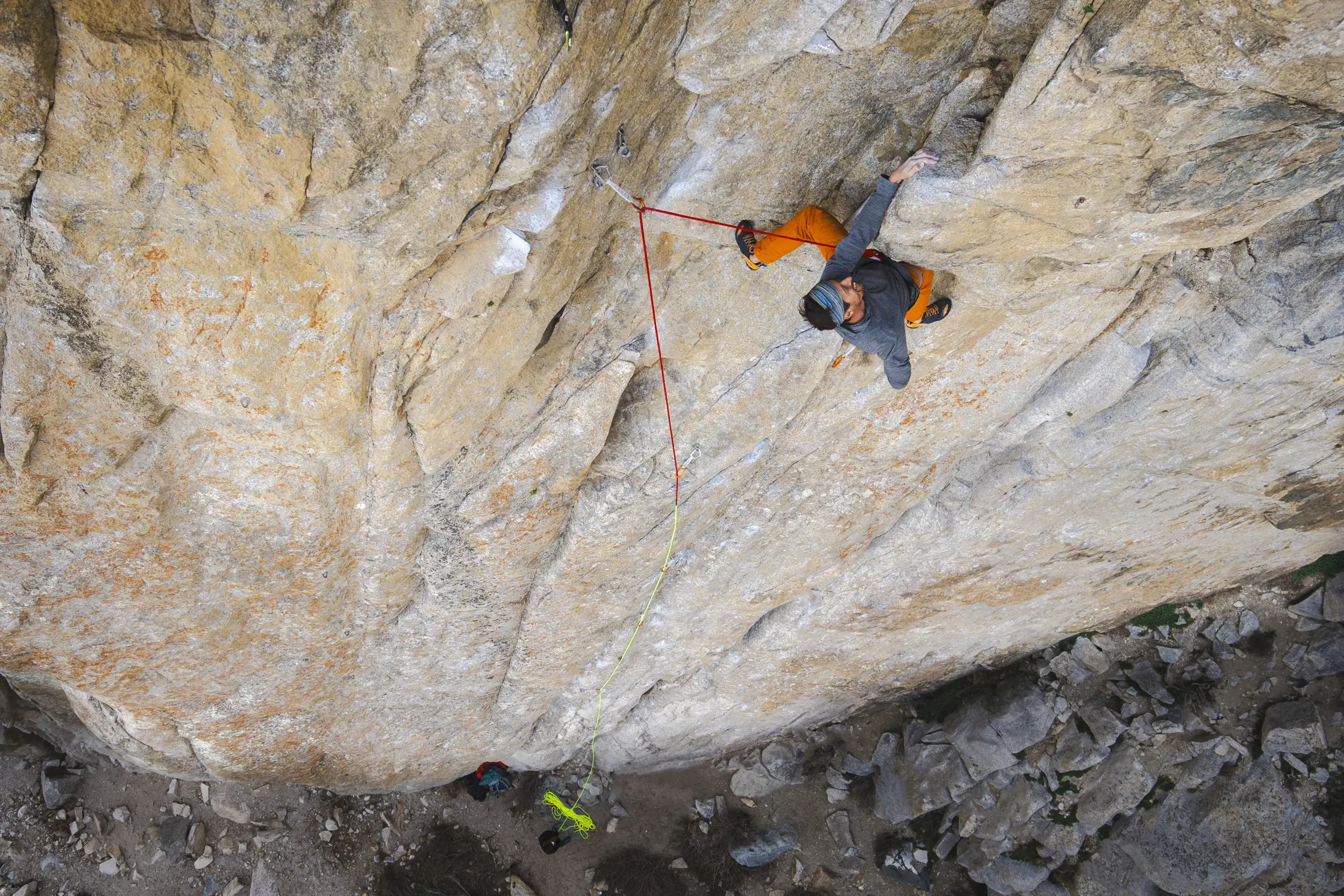



Diameter
The ropes in our review vary from 8.9 mm for the Black Diamond 8.9 Dry to 9.8 mm for the Edelrid Boa Eco 9.8, but the range for single ropes on the market can be as thin as 8.5 or as thick as 11 mm. Thinner ropes will offer a lighter climbing experience and a softer catch, which is ideal for climbing hard sport routes where falls are inevitable and weight matters.
Thicker ropes will be more durable and easier to handle while belaying because of the friction, making them more suitable for top rope or gym climbing, where handling and durability are more important.
It’s also essential to double-check the minimum diameter your belay device can handle. For example, the popular (though no longer in circulation) GriGri 2 works best on ropes from 9.4 to 10.3 mm, while the newer GriGri can handle ropes as thin as 8.5 mm. This information will always be printed on a belay device.
It’s also important to mention that rope diameter certifications have a tolerance of ±0.3 mm, which is why some ropes of the same diameter can feel thinner or thicker than one another, and weigh substantially more or less. With first use, ropes will always feel thinner and slicker before they give way to abrasion, where the sheath inevitably fuzzes up and thickens over time.
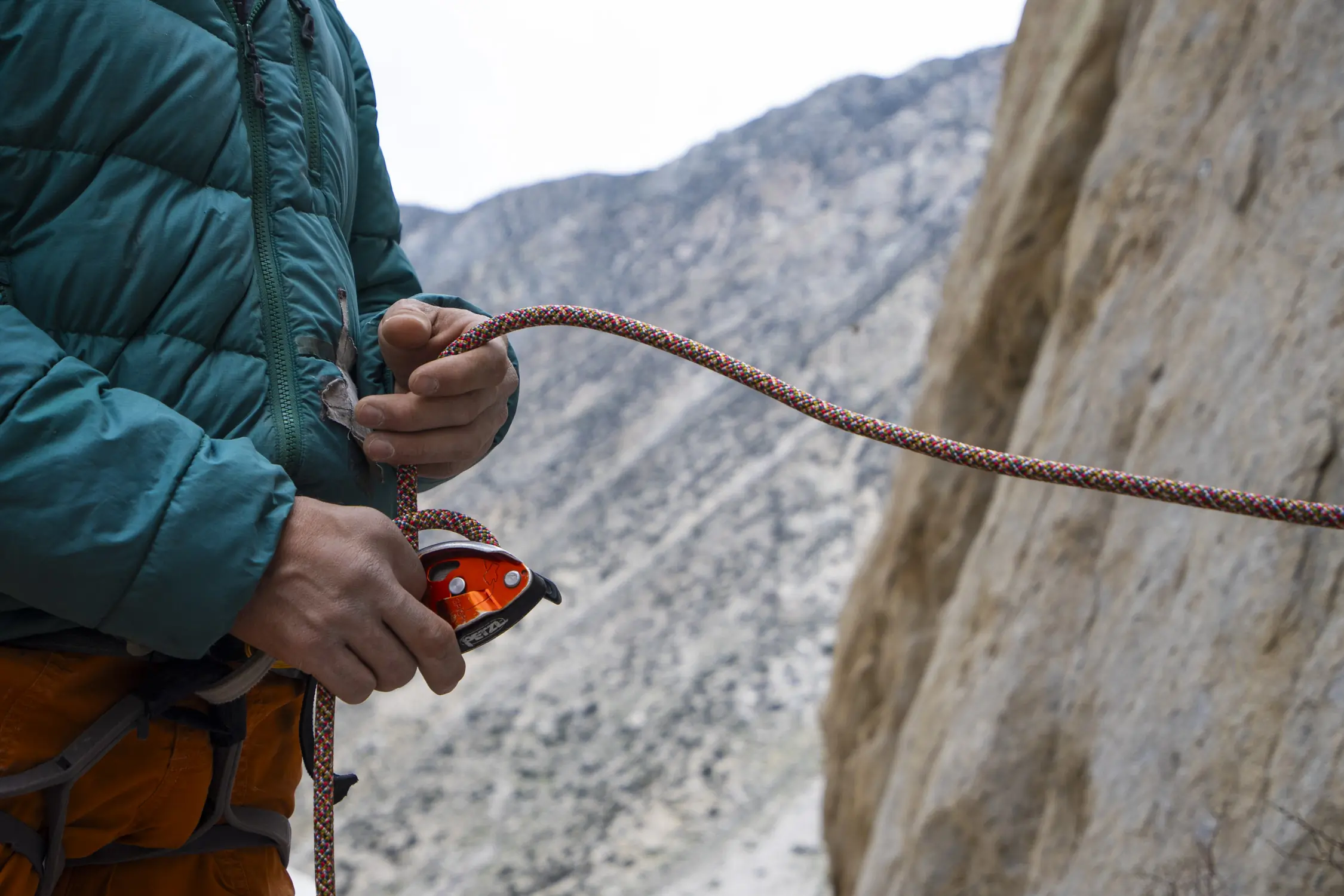



Rope Types
Twin and Half Ropes
For mountaineering, ice climbing, and some alpine climbing, you’ll see folks using twin or half ropes. Twin ropes involve climbing with two thinner ropes, usually 7-8 mm in diameter, whereby the climber clips both ropes into each piece of protection.
This allows the climbers to each carry a rope, provides some redundancy, and allows them to rappel using two ropes instead of one. Every rope will have an indicator on its end to show what type of rope it is. The symbol for a twin rope is:
Half ropes are also typically 7-8 mm in diameter, the difference being that the climber will alternate clipping each rope into different pieces of gear to reduce rope drag, lower the fall force on each piece of gear, as well as provide the same rappelling advantages of twin ropes. One of the main takeaways here is that twin and half ropes are not rated for single use, which means they cannot safely handle a fall on their own, due to their extremely small diameter. The symbol for a half rope is:
Single
Every rope in our review is a single-rated rope, which is the most common rope type, and means they are rated to be used on their own and can sustain many lead falls. Single ropes typically range in diameter from 8.9-10.1 mm, but some go as low as 8.5 mm and as high as 11 mm. Each end of the diameter extreme is more reserved for specialty use. A
skinny rope is good for alpine climbing, where being light and fast is essential. A super thick rope is usually used in gyms and in any rope access-type work where durability is the biggest concern. The symbol for a single rope is:
Feel
While “feel” might seem like a subjective metric, it is an important one that some would like to consider before they purchase an expensive rope. There are a few factors that give a rope its own “feel,” the first one being its diameter. The smaller the rope, the more quickly and easily it will pull through a belay device, and the more it will require an attentive, experienced belayer. The thicker the rope, the more friction it will have, thus providing an easier, safer handling experience.
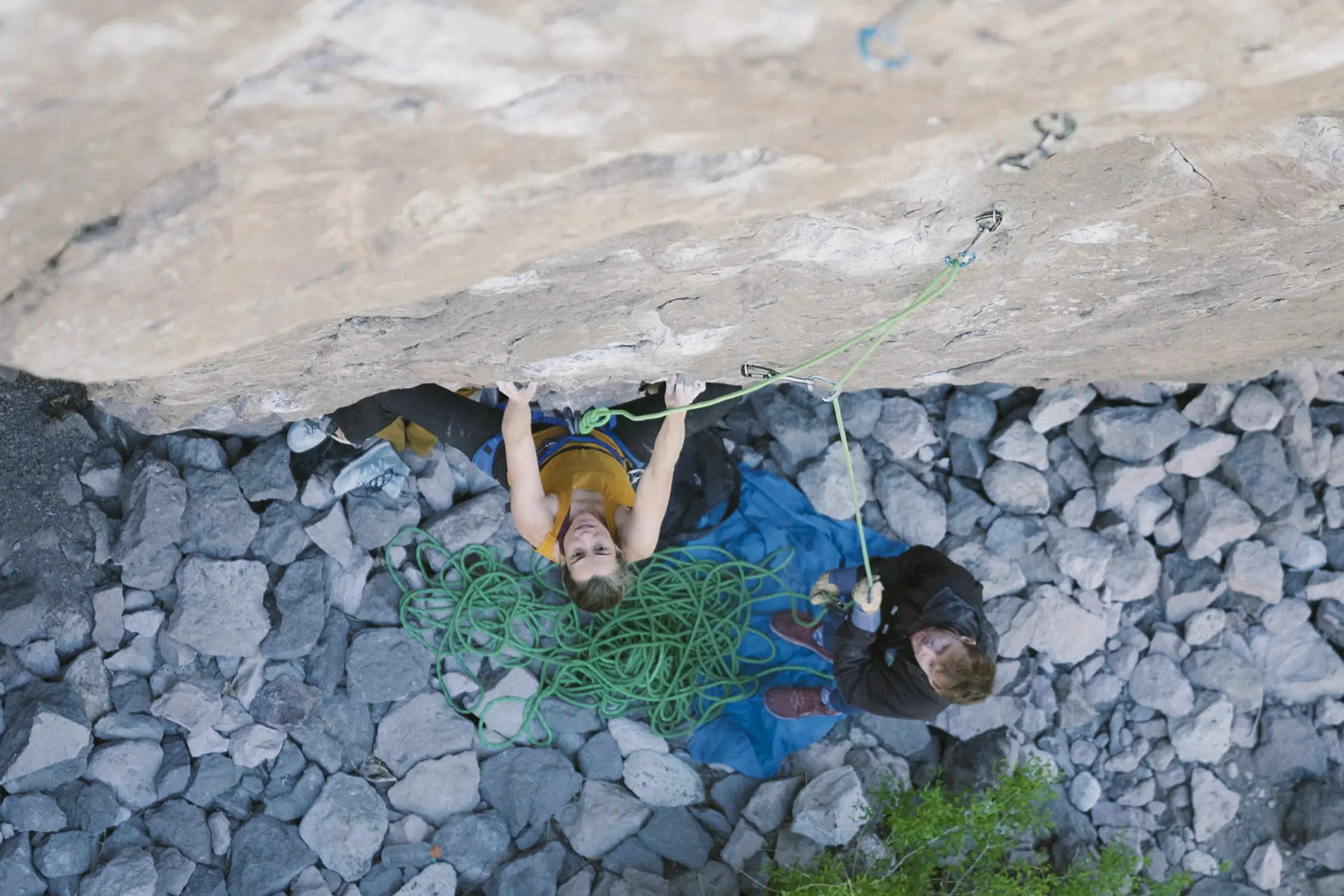



Sheath Construction
The sheath construction also gives a rope its own individual “feel.” This comes down to many specific variables in the manufacturing process, but to simplify things a bit, the sheath-to-core ratio significantly influences a rope’s feel.
A thicker sheath-to-core ratio will typically cause a rope to feel stiffer but will increase its durability, like with the Edelrid Tommy Caldwell Eco Dry DuoTec 9.6. A thinner sheath-to-core ratio will cause a rope to feel more smooth and supple but will be more susceptible to wear and tear over time.
Whether or not a rope has a dry treatment will also affect its feel. A typical dry treatment involves dipping the whole rope in a chemical bath. This causes the sheath to have a slick, somewhat “gummy” feel to it. However, rope manufacturers are now treating the individual filaments of the core and sheath, as found on the Sterling IonR 9.4 BiColor XEROS and the Trango Agility Duo Dry 9.1, which creates a more supple product overall.
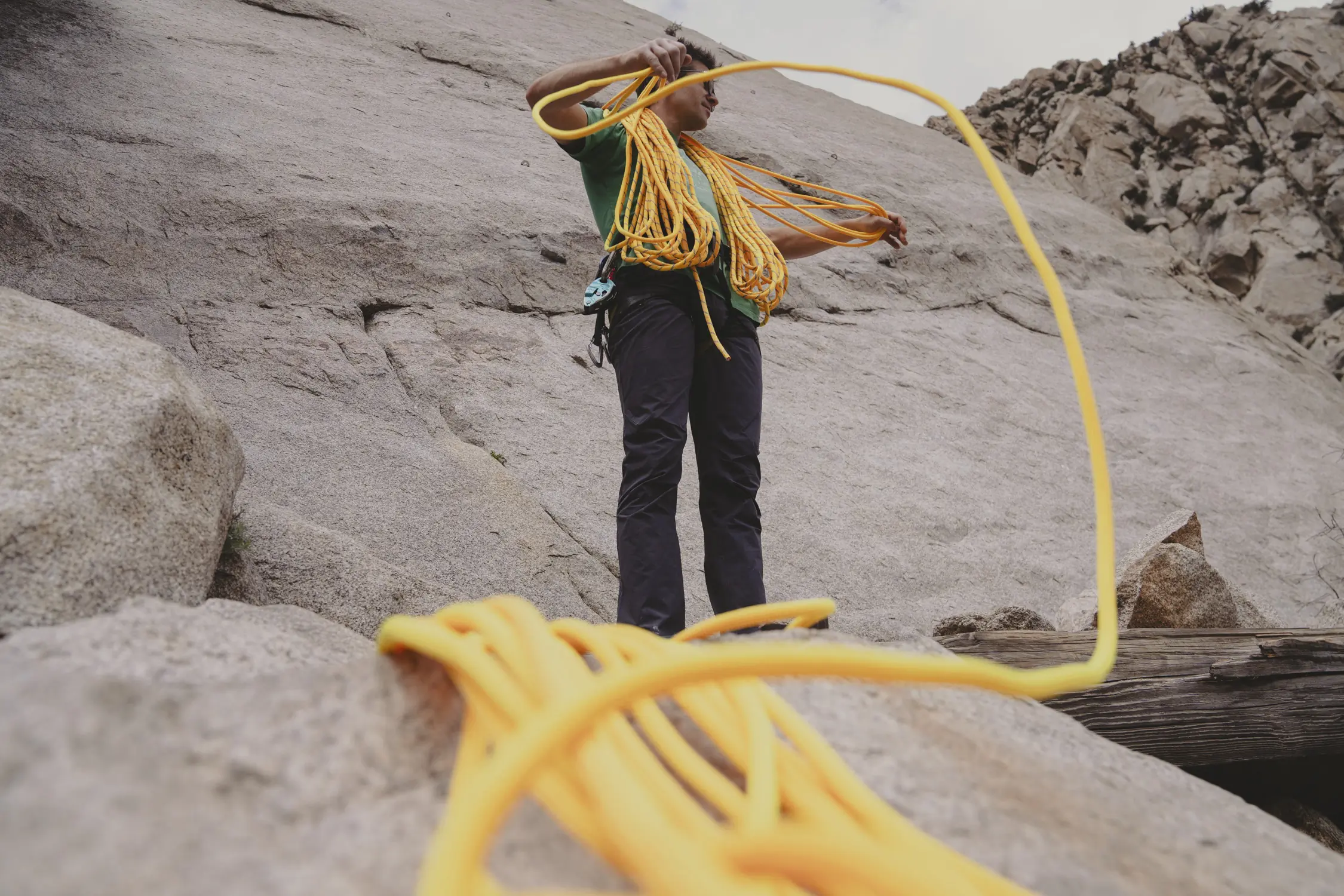



The feel of a rope will also change significantly over its lifespan. A fresh rope will always feel slick out of the package, but as the sheath gets worn and abraded over time, it will fuzz up and thicken. We find this happens most significantly with the Black Diamond ropes. In our experience, Sterling ropes, such as the Sterling Aero 9.2 XEROS Rope, maintain its size and feel quite well over time, remaining soft and not thickening too much with use.
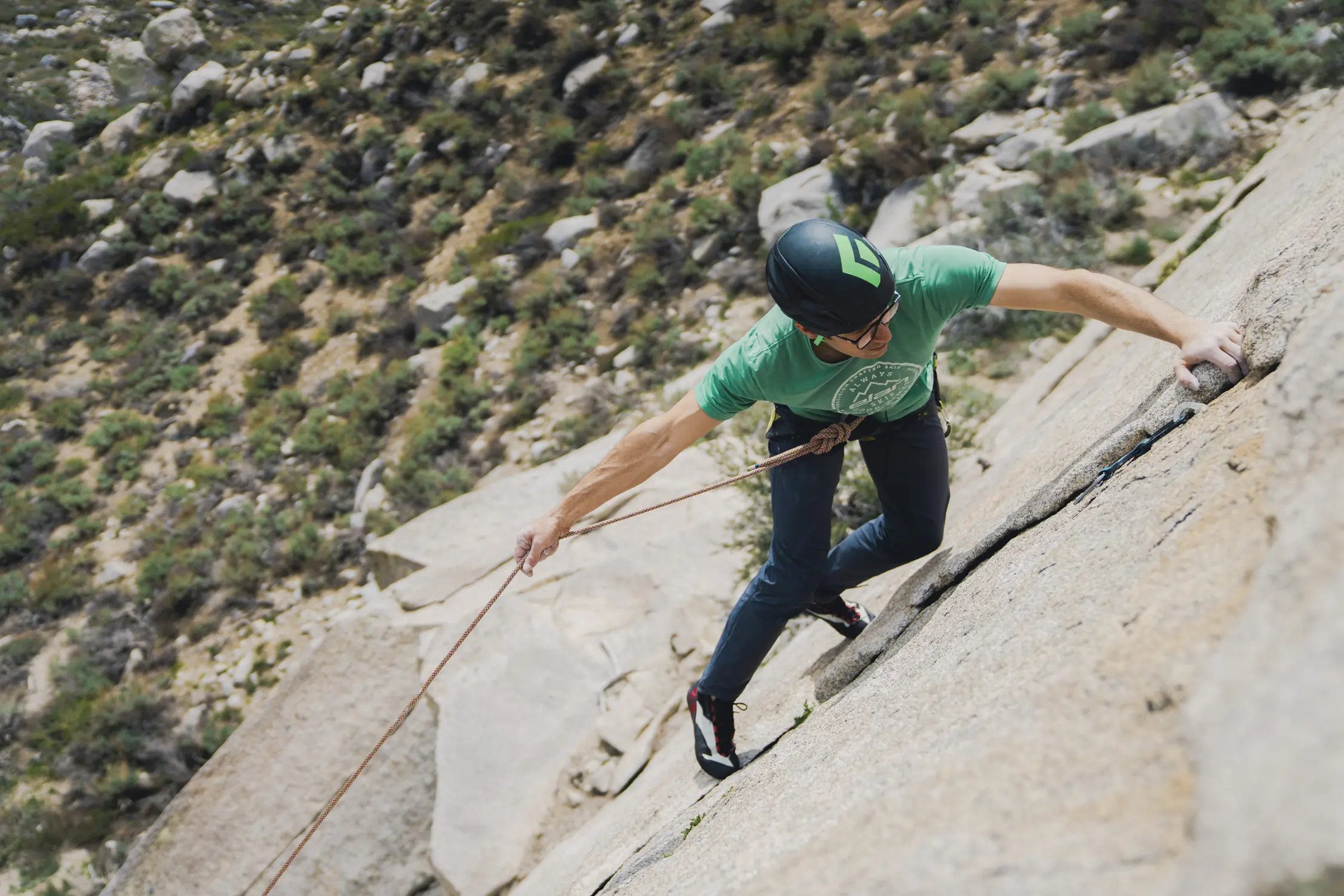



Durability
Several factors play into how durable a climbing rope will prove to be over time. This category has some objective components, like the aforementioned total diameter of the rope, or the core-to-sheath ratio, but there are less easily measured factors that come into play as well, such as how the rope is used and what types of falls it catches. Here are some aspects that contribute to the durability of your rope:
Diameter: Generally, the thicker the rope, the more durable.
Sheath-to-core ratio: The sheath ratio of a climbing rope is typically between 35-45%. Ropes that are used frequently such as gym top ropes, will want to have a sheath of at least 45% to increase their lifespan. The sheath percentage of a rope is a good indicator of its durability, and the Edelrid Tommy Caldwell Eco Dry DuoTec is a rope marketed specifically for its higher sheath-to-core ratio. However, a thicker sheath will make a rope feel stiffer.
Usage: How frequently and in what conditions the rope is used greatly impacts its durability. Frequent falls, lots of top roping, sharp edges, and exposure to dirt and moisture all contribute to wear and tear. It’s good practice to make sure your rope doesn’t run over sharp edges that could cause dangerous abrasion. Always inspect your hardware and a route’s hardware for any sharp grooves, and frequently change which side of the rope you use to balance out its wear.
Environmental factors: Exposure to UV radiation from sunlight can degrade the rope’s fibers over time. Extreme temperatures can also weaken the material. Storing the rope properly when not in use helps mitigate these effects. Never put your rope on surfaces where it could pick up dirt or chemicals, like parking lots where oil could seep into the rope.
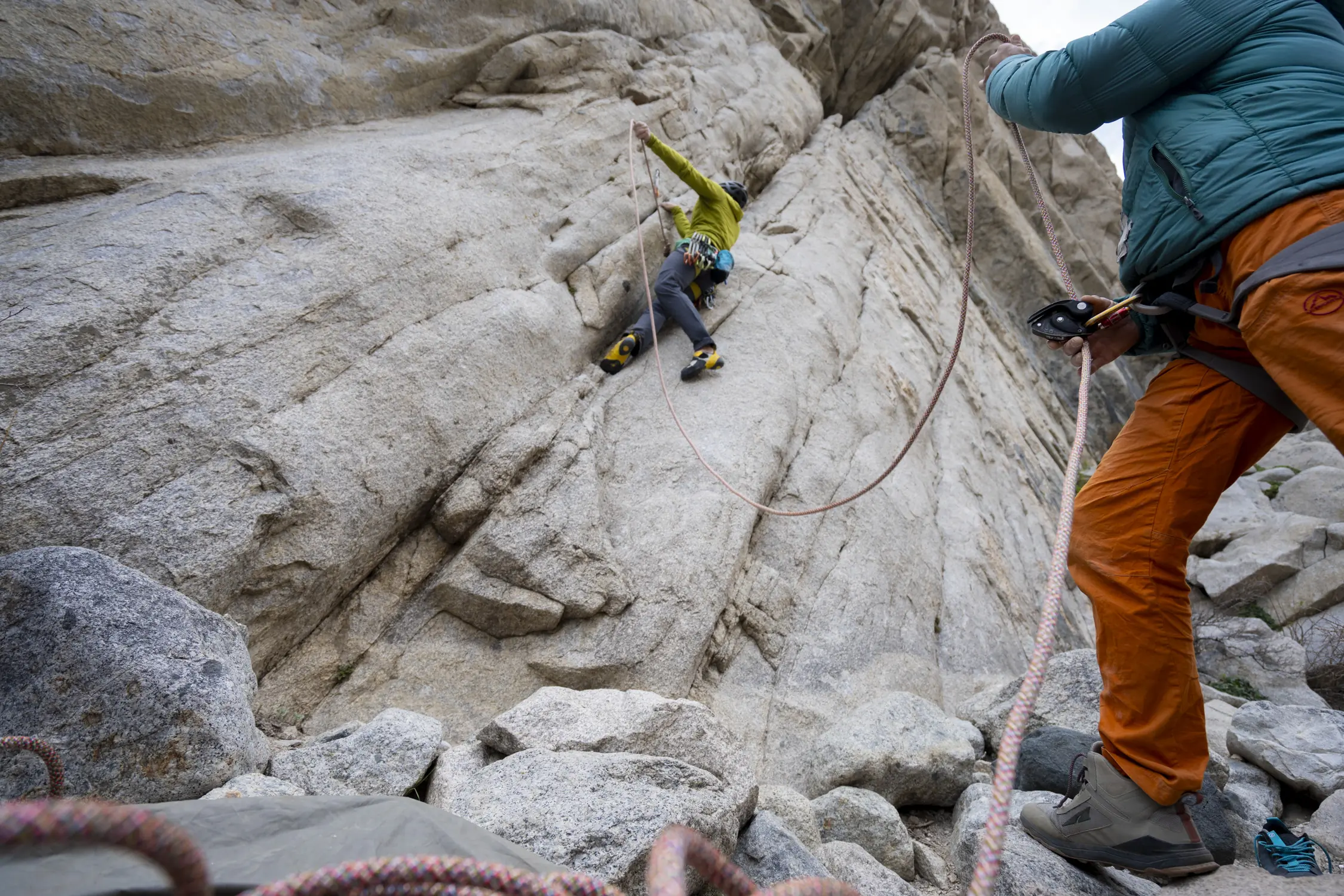



Dry vs. Non-dry Treatment: If you’re like us, you might have thought that dry-treated ropes were only for those into ice climbing and mountaineering. But they actually serve a purpose beyond just defending your rope from getting soaked, and can be a great option for the everyday climber who wants a more durable rope.
Having a dry-treated rope will also protect the sheath and core from grit and dirt, which will quickly shorten the lifespan of your rope through micro-abrasions over time. The Mammut Crag We Care Classic 9.5 and the Edelrid Boa Eco 9.8 are the two ropes we reviewed that are not dry-treated but are also significantly less expensive as a result.
Types of climbing and falls: Lastly, the type of climbing you do will also affect the durability of your rope. If you plan on doing a lot of top roping, your rope will be susceptible to more external wear as it rubs continuously through anchor hardware. If you do a lot of projecting, your rope will also be susceptible to wear from hang-dogging and working moves, plus inevitably taking decent lead falls. It’s important to switch the ends of the rope you climb on often during this type of climbing to disperse the wear.
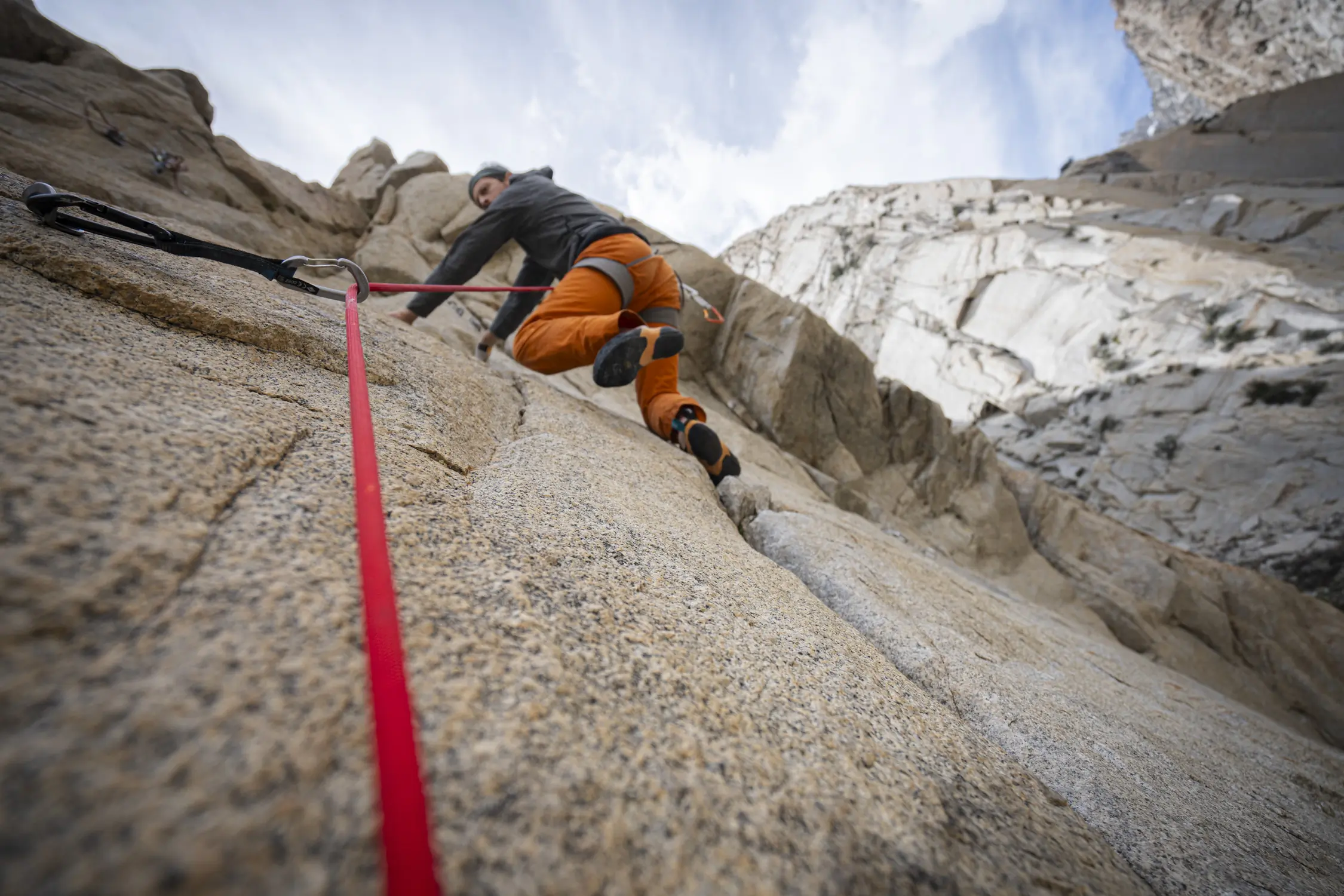



Proper Care and Maintenance
Regular inspection and proper care can greatly extend the lifespan of a climbing rope. This includes using a rope tarp, avoiding stepping on the rope, keeping it clean, storing it away from sunlight and chemicals, and even giving it a bath and a scrub every once in a while if you’re really dedicated.
Additionally, always inspect the rope for any soft or flat spots that might indicate a torn core. If this happens close enough to the end of your rope, you can always take it to a gear shop and get it cut, making sure to note how long your rope is afterward.
UIAA Fall Rating
This is actually not a direct measure of durability, but it is important to note as there is some confusion around what a fall rating for a rope means. The UIAA (International Climbing and Mountaineering Federation) fall rating is a standardized measure used to indicate the number of simulated falls a climbing rope can sustain under controlled laboratory conditions before it fails to meet safety standards. All single ropes must withstand a minimum of 5 UIAA falls to be certified.
But these falls are not normal top rope or lead falls. These simulated falls are extremely bad falls with a fall factor of 1.7, which rarely occurs in climbing and would mean that you would be falling 2x the distance of the length of the rope in the system. The UIAA test involves doing a drop test with a weight on a rope to create a fall factor of 1.7, and is repeated every 5 minutes until the rope fails, which would be next to impossible to happen in a real-world climbing scenario.
While all climbing ropes have to go through this testing and certification process, the only thing this tells us is that each rope has passed an intensive testing process in a controlled setting and has a safety margin way beyond what would occur in the real world.
And though some ropes we tested, such as the Trango Agility Duo Dry, have a fall rating of 8 while the Sterling IonR 9.4 BiColor XEROS has a fall rating of 5, there are so many other factors that contribute to the durability of a rope, such as the ones listed above that the fall rating is not one we really look for in relation to this metric.
Overall, the durability of a climbing rope depends on a combination of all of these factors, and proper attention to care and maintenance can significantly extend your rope’s lifespan.
Design
When considering buying a rope, there are some design features of certain ropes that can increase their margin of safety. Most ropes come with a middle marker, where the middle of the rope is marked with black ink.
Unfortunately, this mark will fade over time and become harder and harder to locate as the sheath gets worn down. You can buy a rope marker, like the one made by Black Diamond, to safely darken the middle again, though you’ll likely have to keep applying this time and time again.
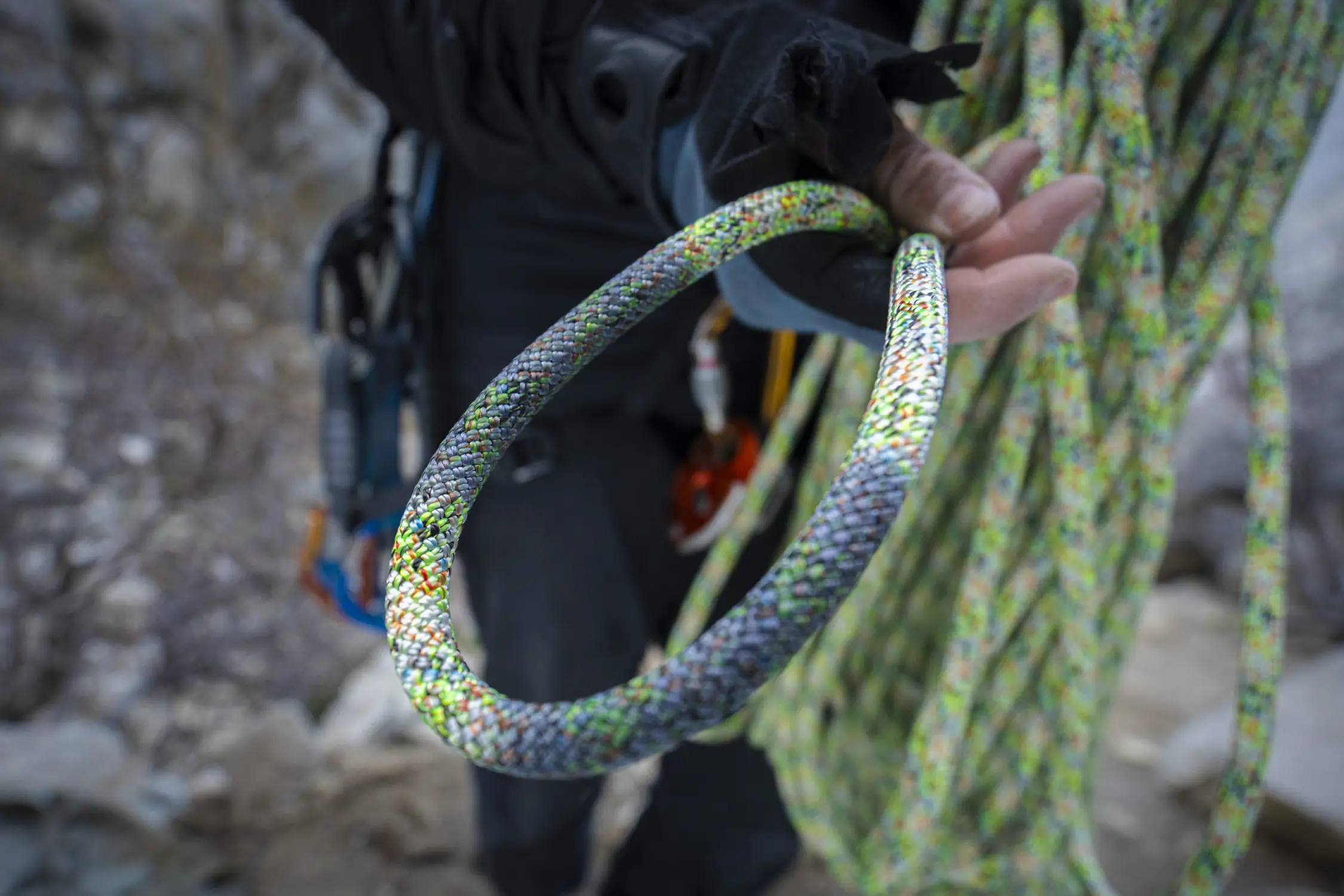



This is where bi-pattern ropes come in. Ropes such as the Sterling IonR 9.4 BiColor XEROS or the Edelrid Tommy Caldwell Eco Dry DuoTec are half-solid, half-patterned, so you can permanently identify the middle of the rope. These ropes are great for multi-pitch climbing, where you can quickly shout up to your climber when they are approaching halfway, and for when you’re making multiple rappels and need to consistently find the middle while threading the rope through rap rings.
Another design trend that we hope catches on can be found on the Trango Agility Duo Dry with its “Red Flag” treatment, in which the last 5 m of each end of the rope are colored bright red as a warning. Most climbing accidents occur while rappelling, and these rope designs significantly increase the likelihood that you won’t make as many mistakes during this dangerous process.
It’s still a very good idea to always tie knots at the ends of your rope for extra precaution while rappelling or lowering someone, but we are a big fan of ropes that integrate safety into their designs.
Price & Value
For a piece of gear that might only last a season of hard use, climbing ropes can seem very expensive. On the flip side, a rope is really the only thing between you and a death fall, and while you can be redundant with your pro, you’ve only got one rope. Length, manufacturing processes, and other performance factors can affect price.
Fortunately, they only marginally affect safety, so even the least expensive model we tested can still give you a safe, dynamic catch. You can save a little money by purchasing a shorter rope, but for comparison’s sake, we’ll be discussing 70-meter ropes.
Budget
In the $250 or less price range, ropes are single-pattern and often lack a dry treatment. You’ll need to pay extra close attention to the middle mark when rappelling, and you shouldn’t use them for ice climbing, as getting wet will affect the dynamic performance.
But fair-weather climbers can still get plenty of mileage out of these ropes. At $199, the Mammut Crag We Care is an excellent all-rounder and a great deal for a 70-meter length. Its 9.5 diameter makes it just light enough to carry into the mountains, and it handles well in a GriGri.
Mid-Tier
Most ropes in the $250-300 price range have a dry treatment and a diameter under 9.5 mm. Why spend money on a dry rope if you never climb in the rain? Dry treatments have been shown to repel silt and fine dust that can degrade the sheath of a rope over time. This type of dust is common in the well-traveled areas at the base of many popular crags.
If you do get caught in the rain, dry treatments are crucial for maintaining the strength and dynamic performance of your rope. The Black Diamond 8.9 Dry Climbing Rope ($300) is a skinny cord that can handle a season of sport whippers but is even better as a lightweight rope for alpine climbing. The Sterling Aero 9.2 XEROS ($280) is a touch heavier at 56 grams per meter, is more durable than the BD 8.9, and has Sterling’s proprietary XEROS dry treatment applied to the core of the rope.
Premium
Premium ropes are usually dry-treated and have a bi-pattern. As we’ve discussed above, bi-pattern ropes spin two patterns together at the middle of the rope, so you’ll always be able to distinguish the middle when rappelling or lowering another climber. Many ropes are available in bi or single-pattern options, so if you like the specs of a bi-pattern rope, you can often buy the single-pattern version for less.
In our humble opinion, the Sterling Ion 9.4 BiColor XEROS ($350) is a deluxe rope, great for any cragging scenario, tough enough for a little top-roping, and light enough for long and difficult pitches.
The priciest rope we tested is the Trango Agility Duo Dry 9.1mm ($450). This rope has a unique safety feature, where the last 15 feet of both ends are red, giving a strong visual warning to the climber that they are nearing the end of the rope. On top of that, it’s a skinny high-performer that has stood up to months of use on mutipitches and at the crag.
Frequently Asked Questions
Dynamic ropes are designed to stretch to absorb the energy of a fall, reducing the impact force on the climber and gear. Static ropes, on the other hand, do not stretch significantly and are primarily used for rigging, rescue, and rappelling.
The diameter of a climbing rope affects its weight, durability, and handling characteristics. You’ll want to buy a thicker rope if you plan on doing a lot of gym or top-rope climbing, and you’ll prefer a thinner rope for performance-oriented sport or trad climbing, as well as alpine climbing where weight matters.
The UIAA (International Climbing and Mountaineering Federation) and CE (Conformité Européenne) certifications ensure that climbing ropes meet certain safety and quality standards. These certifications indicate that the rope has been tested and approved for use in climbing applications.
Climbing ropes have a limited lifespan and should be retired after a certain amount of use or if they show signs of damage or wear. The exact replacement interval depends on factors like frequency of use, type of climbing, and environmental conditions.
Manufacturers typically provide guidelines for rope retirement based on these factors. It’s always good to check your rope frequently for any soft or flat spots indicating that the core might be compromised. If this happens close to the ends where much of the wear on a rope occurs, you can always cut the rope and make careful note of its new length.
Proper care and maintenance are essential for prolonging the lifespan of a climbing rope. This includes avoiding contact with sharp edges and abrasive surfaces, keeping the rope clean and dry, using a rope tarp when belaying outside, storing it away from sunlight and chemicals, regular inspections, and if you’re really motivated, giving it a bath every once in a while.
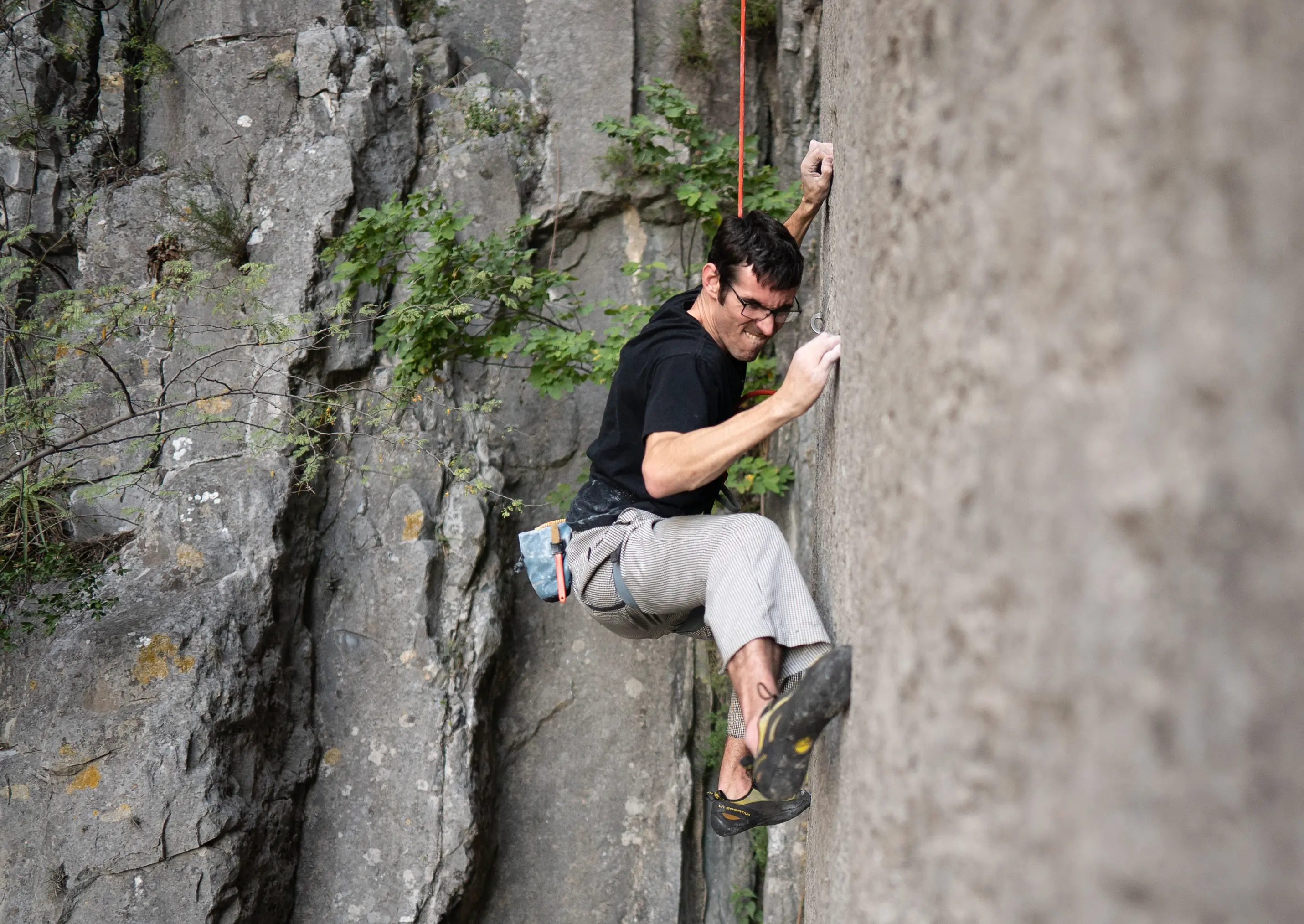

The Best Climbing Shoes of 2025
Aside from the ice climbers, mountaineers, and Charles Albert, every climber needs a pair of reliable climbing shoes.


The Best Climbing Harnesses of 2025
We found the best climbing harnesses of 2025. Whether you’re sport climbing or mountaineering, we have you covered.

